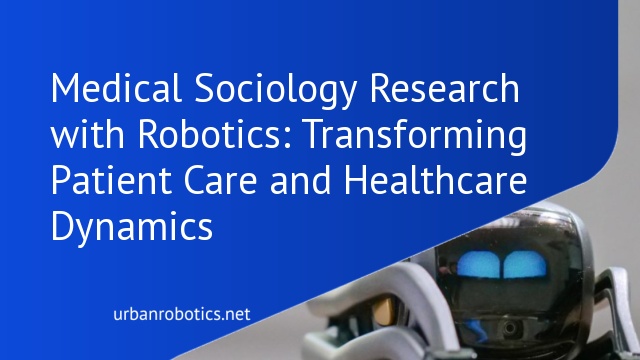Understanding Medical Sociology
Medical sociology examines the social dimensions of health and illness, focusing on how societal factors influence healthcare experiences. It delves into patient behaviors, healthcare providers’ roles, and the social implications of medical practices. By understanding these aspects, we gain insights into health disparities and systemic issues affecting healthcare delivery.
Healthcare systems reflect societal structures, mirroring inequalities and cultural norms. For example, socioeconomic status often determines access to medical resources. Medical sociologists analyze this data to recommend policy changes aimed at improving equity in healthcare.
Additionally, medical sociology explores doctor-patient relationships, analyzing how communication and trust affect treatment outcomes. Effective healthcare extends beyond medical knowledge to include understanding patients’ social backgrounds and cultural contexts.
Technological advancements, including robotics, challenge traditional medical sociology paradigms. Robots in healthcare reshape patient interactions and provider roles, necessitating new research to understand these evolving dynamics. By integrating robotics into medical sociology research, we can evaluate the broader impact on health systems and society, ensuring that innovations benefit all stakeholders equitably.
The Role of Robotics in Healthcare
Robotics is playing an increasingly vital role in transforming healthcare delivery and medical sociology landscapes. It enhances precision, efficiency, and accessibility in patient care.
Rise of Robotics in Medicine
Robotics in medicine has seen rapid advancements in recent years. Surgical robots like the da Vinci system perform precise, minimally invasive procedures. Hospital robots assist with tasks such as patient monitoring, medication delivery, and sanitation, reducing workload on healthcare professionals (e.g., TUG robots in hospitals). These innovations improve patient outcomes and operational efficiency.
Examples of Medical Robotics
Various types of medical robotics exist. Surgical robots, like the da Vinci system, enable high-precision surgeries. Rehabilitation robots, such as the Lokomat, aid patient mobility recovery through consistent, repetitive movements. Diagnostic robots, like Endoscopy-BOT, provide accurate internal scans. These examples showcase the broad application of robotics in different healthcare areas, enhancing medical procedures and patient care.
Research Trends in Medical Sociology with Robotics
The intersection of robotics and medical sociology is spurring notable research trends. We’re seeing a broad spectrum of key areas and innovative methodologies that are driving this interdisciplinary field forward.
Key Research Areas
Researchers are focusing on equity in access to robotic healthcare solutions. Studies examine how robotics impacts patient-provider relationships, particularly in diverse demographic groups. Another critical area of research is the ethical implications of robotic interventions in medical procedures. Scholars also investigate the societal perceptions and acceptance of robotics in healthcare, assessing how these attitudes influence policy and practice.
Methodologies Used
Researchers use mixed-method approaches to gain comprehensive insights. Quantitative methods, like surveys, measure patient outcomes and satisfaction. Ethnographic studies provide qualitative data on patient experiences, allowing for in-depth understanding. Simulation studies test the efficacy of robotic systems in controlled environments, ensuring reliability before wider implementation. By combining these methodologies, researchers can effectively analyze the complex dynamics between robotics and medical sociology.
Impacts on Patient Care and Society
The intersection of robotics and medical sociology has significant effects on patient care and society. Integrating robotics into healthcare settings brings numerous benefits and challenges.
Benefits of Robotics in Patient Care
Robotics in healthcare improves precision and efficiency. Surgical robots like the da Vinci system offer minimally invasive procedures, reducing recovery times. Rehabilitation robots assist patients in regaining mobility faster. Diagnostic robots enhance accuracy, leading to more timely treatments. These advancements contribute to overall improved patient outcomes and higher satisfaction rates. Patients experience fewer complications and shorter hospital stays due to the precise and efficient capabilities of medical robots.
Ethical Considerations
Introducing robotics in healthcare raises ethical concerns that need addressing. Issues of accessibility and equity come to the forefront—ensuring every patient has equal access to robotic healthcare solutions is critical. Privacy concerns arise when robots handle sensitive patient data. There’s also the matter of accountability when errors occur during robotic interventions. We must navigate these ethical challenges carefully to integrate robotics into healthcare responsibly, guaranteeing that benefits are equitably distributed and patient trust is maintained.
Future Directions in Medical Sociology Research
Advancements in robotics open new avenues for medical sociology research, emphasizing the dynamics between technological innovation and societal impacts in healthcare.
Emerging Technologies
Artificial intelligence (AI) and machine learning (ML) present promising avenues for enhancing robotics in medical settings. New developments include AI-driven diagnostics, predictive analytics, and personalized treatment plans that streamline patient care. Additionally, telepresence robots facilitate remote care, expanding accessibility to underserved populations. The potential of these technologies reshapes our understanding of patient-provider interactions and healthcare delivery systems. Research can explore the social implications of these integrations, examining how technological advancements alter experiences and outcomes.
Potential Challenges
Integrating robotics in healthcare introduces substantial challenges. Financial barriers may limit access to these advanced technologies, exacerbating existing disparities. Ethical concerns, such as privacy, data security, and patient autonomy, necessitate rigorous standards. Additionally, workforce displacement due to automation requires consideration of new roles and training programs for healthcare professionals. Research in medical sociology must address these issues, developing policies that ensure equitable access and maintain ethical standards. Exploring solutions could lead to more inclusive and responsible integration of robotics in healthcare systems.
Conclusion
The convergence of robotics and medical sociology is revolutionizing healthcare. We’re witnessing unprecedented advancements that not only enhance patient care but also reshape societal dynamics within medical settings. It’s essential to consider societal factors in healthcare to drive meaningful policy changes.
The future of medical sociology research is promising, with AI and ML poised to further elevate the role of robotics in healthcare. However, it’s crucial to address challenges like financial barriers, ethical concerns, and workforce displacement to ensure equitable and ethical integration of these technologies.
Our ongoing research and policy development will be vital in navigating these complexities and harnessing the full potential of robotics in transforming healthcare for the better.





